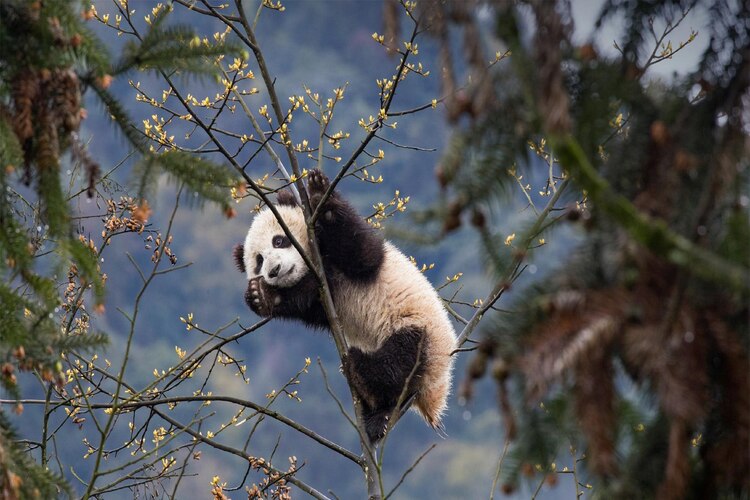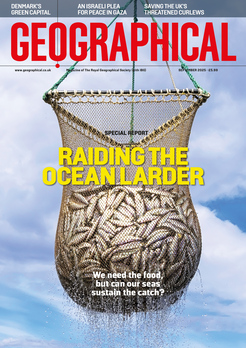
Both in the wild and in captivity, giant panda populations are starting to recover – but are still far from secure
By
The recent news of a South Korean giant panda, Ai Bao, birthing twins in a zoo on Friday is certainly welcome – with only a 50 per cent chance of giant pandas giving birth to twins, and the female’s short 24-36 hour fertility window each year – as new panda cubs are a much-needed boost to the population of a species previously listed as endangered.
Born in the Everland Resort theme park, southeast of Seoul, these two panda cubs are the first panda twins born in South Korea – with Ai Bao also giving birth to a cub, Fu Bao, just three years ago.
Related articles

But the rehabilitation of an endangered population – now upgraded to ‘vulnerable’ by the IUCN Red List – began much before this – back in the early 1960s, when the first four panda reserves were created in China. Now, there are between 500 to 1,000 mature giant panda (Ailuropoda melanoleuca) adults living in the wild, and more than 40 panda reserves in Southwestern China – ranging from protected habitats in nature reserves to those with scientific research centres to monitor behaviour and breed giant pandas.
Reversing habitat loss for giant pandas
Between 2003 and 2015, the giant panda population – which only lives in temperate bamboo forests – increased by 16.8 per cent to 1,864.
Before then, increasing environmental pressures – such as mineral exploitation, deforestation and poaching – on the giant panda, had caused habitat loss and a declining population. According to Head of the IUCN Red List, Craig Hilton-Taylor, the 1980s marked a significant period of habitat loss for the giant panda, plummeting the population to just over 1,200.
In response to this declining population, the Chinese government enforced the Wildlife Protection Law in 1988, ensuring endangered animals – which the giant panda was listed as at the time – were adequately protected from persecution and human interference. In 1998, a ban was enforced on logging – a practice detrimental to the habitat of giant pandas – in the hopes of further increasing numbers.

Despite these measures, the giant panda still suffers the effects of previous habitat loss, which has caused the species to live in isolated communities within fragmented habitats. Now, the giant panda occupies just 20 isolated bamboo forest patches in six mountain ranges across China.
Previous studies on the genetic diversity of these various, small populations have shown that they are at high risk of entirely dying out if habitat corridors are not created.
These bamboo corridors can link otherwise fragmented areas of forest, allowing giant pandas to move between habitats, find food and encourage the species to find new breeding mates. In Sichuan alone, six ecological corridors have been established as of 2021, at a total cost of $59 million (375 million yuan).
Captive breeding
Attempts to breed pandas in captivity in China began in 1955, but it was not until eight years later, in 1963, that the first ever captive-bred giant panda, was born at the Beijing Zoo. It is argued that captive breeding is essential to enrich the genetic pool for all giant pandas.
Today, artificial insemination can be used to increase the likelihood of panda pregnancy and is similar to the process of IVF in humans. The procedure involves sedating pandas, before obtaining a semen sample from the male which is then inserted into the female.
However, the process is not always successful – with the artificial insemination of Tian Tian, a giant panda housed in Edinburgh Zoo, failing back in 2017. There are also concerns with the rate at which female giant pandas reject cubs born via artificial insemination – around 37.9 per cent more likely compared to females which mated naturally.
Continuing to support giant panda population
With the giant panda still listed as vulnerable – meaning it faces a high risk of becoming extinct in the wild – the conservation efforts of the species are certainly not complete. Although the Chinese government has established more than 50 panda reserves, just 57 per cent of the wild panda population lives in these areas. And large-scale disturbances, such as mining, tourism and hydro-power, continue to threaten the population.
‘Continuing these conservation efforts is critical, but we need to stay vigilant on the current and future impacts climate change may have on giant pandas and their mountainous forest habitat,’ said WWF’s Vice President for Wildlife Conservation, Colby Loucks.
With human development continuing in the world’s most populous country, giant panda habitats are still fragmented by roads, railways and other interferences. Vital, additional ecological corridors must be created, and serious attention must continue to be given to the giant panda to ensure the survival of the species.




